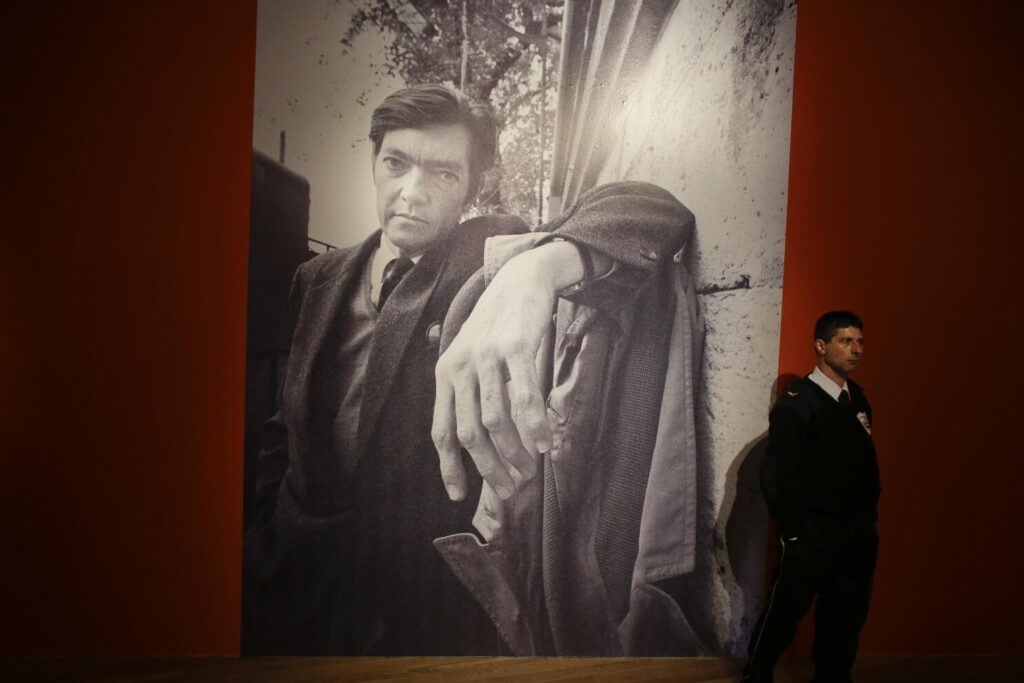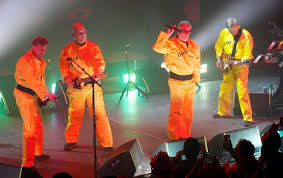
FILE - A security guard stands near a large photo of late writer Julio Cortazar at an exhibit marking the 100-year anniversary of his birth at the National Museum of Fine Arts in Buenos Aires, Argentina, Aug. 26, 2014. A bundle of 60-year-old pages of Cortazar´s writings was sold at auction on Thursday, October 12, 2023, by the Zorrilla de Montevideo auction house. (AP Photo/Victor R. Caivano, File)
A buyer from Argentina paid $42,120 for a manuscript of works, including seven unpublished stories, by legendary Argentine writer Julio Cortázar at an auction Thursday in the Uruguayan capital, Montevideo.
The bundle of 60-year-old sheets bound together with metal fasteners bearing the inscription “Julio Cortázar. Historias de Cronopios y de Famas. Paris. 1952” was the basis for the writer’s iconic “Cronopios and Famas” book, published in 1962.
The buyer paid $36,000, plus the auction house’s 17% commission, for the typewritten manuscript containing 46 short stories that make up the heart of what ended up becoming one of Cortázar’s most famous works.
Of the total stories, 35 were published in “Cronopios and Famas.” Some were printed exactly as found in the manuscript that was once thought to be lost forever. It was discovered in Montevideo last year, while others underwent editorial changes. Three other stories were published in magazines before Cortázar’s death in 1984.
The seven unpublished works are: “Inventory,” “Letter from one fame to another fame,” “Automatic Butterflies,” “Travels and Dreams,” “Tiny Unicorn,” “Mirror’s Anger” and “King of the Sea.”
The 60 yellowed sheets had a starting bid of $12,000 and were being auctioned by Zorrilla, an auction house in Montevideo, in partnership with the Buenos Aires art antique dealer Hilario.
In 1952, Cortázar sent a manuscript titled “Stories of Cronopios and Famas” from Paris to Luis María Baudizzone, the head of Argentine Argos publishing. Baudizzone, a personal friend of the writer, who at the time had only published his first novel, “Bestiario,” never responded, according to Cortázar scholars.
“These little tales of cronopios and famas have been my great companions in Paris. I jotted them down on the street, in cafes, and only two or three exceed one page,” Cortázar wrote to his friend Eduardo Jonquiéres in October 1952. In the same letter, he informed Jonquiéres that he had sent a typescript to Baudizzone.
More than half a century later, the typescript began to be studied by specialists when the son of a book collector, who had passed away in Montevideo, found it at the bottom of a box with other materials.
“It was something that had been lost,” Roberto Vega, head of the Hilario auction house, told The Associated Press. “The book was in an unlisted box. It could have happened that the collector died, and things could have ended up who knows where. It could easily have been lost.”
Vega speculates that Cortázar “lost track of the manuscript” after he sent it to Baudizzone.
The collector’s family, who requested anonymity, does not know how Cortázar’s manuscript ended up in the estate of the deceased, who had silently cherished it. The heir contacted Lucio Aquilanti, a Buenos Aires antiquarian bookseller, and a prominent Cortázar bibliographer, who confirmed the piece’s authenticity.
Institutions, collectors and researchers from both the Americas and Europe had been inquiring about the manuscript recently because of its rarity.
“Very few originals by Cortázar have been sold,” Vega said.







